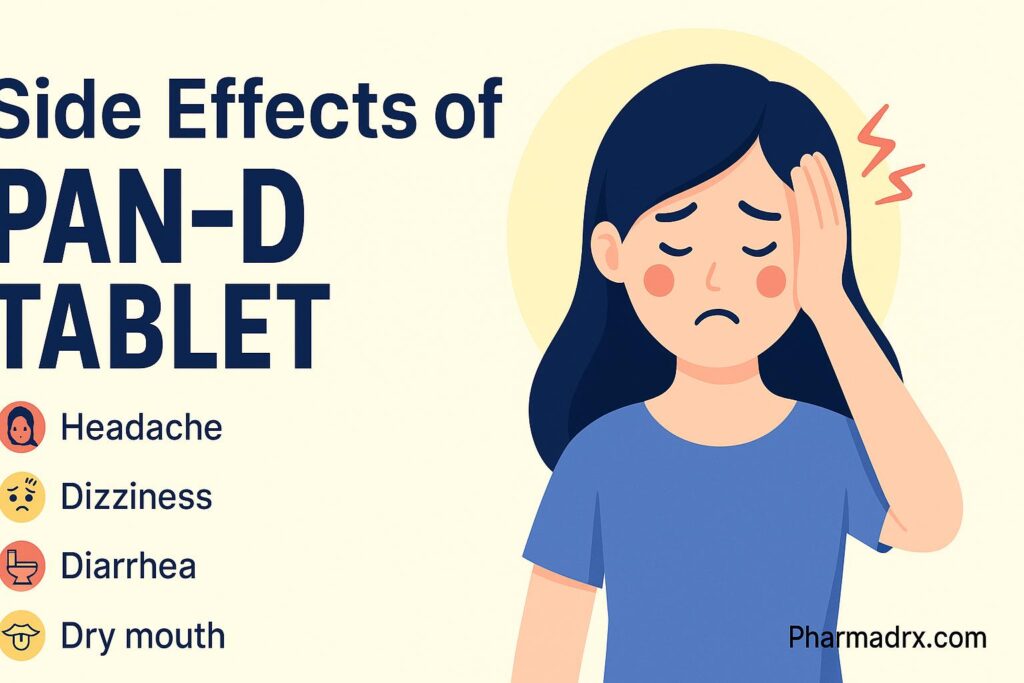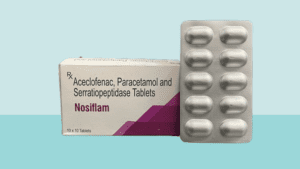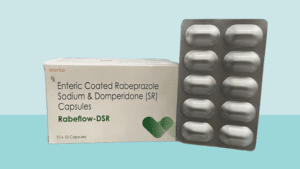How to work Pan D ?
Pan-D is a tablet that contains two medicines: pantoprazole and domperidone. Pantoprazole works by reducing the acid produced in your stomach, which helps treat conditions like acid reflux, heartburn, and ulcers. Domperidone helps your stomach empty food faster and reduces symptoms like nausea, bloating, and a feeling of fullness. Together, these two ingredients improve digestion and give relief from stomach discomfort. Pan-D should be taken before food, usually in the morning. Swallow it whole with water and do not crush or chew it. While taking Pan-D, avoid spicy foods and alcohol, and follow your doctor’s advice, especially if you are pregnant or have liver problems.
Composition of Pan D tablet
The composition of Pan-D includes two active ingredients: Pantoprazole and Domperidone. Each Pan-D tablet contains 40 mg of Pantoprazole and 10 mg of Domperidone. Pantoprazole reduces stomach acid, while Domperidone helps with digestion and prevents nausea. Together, they work to relieve symptoms like acid reflux, heartburn, and indigestion.
Uses of pan D tablet
- Treats Acidity and Heartburn
Pan D tablet helps reduce excessive stomach acid, providing relief from burning sensations in the chest (heartburn) and sour belching caused by acid reflux. - Manages GERD (Chronic Acid Reflux)
It is prescribed for gastroesophageal reflux disease (GERD), where stomach acid repeatedly flows back into the esophagus, damaging its lining and causing persistent discomfort. - Heals Peptic Ulcers
The medication aids in healing ulcers formed in the stomach or duodenum (first part of small intestine) due to prolonged acid exposure or H. pylori bacterial infection. - Reduces Gastritis Inflammation
Pan D helps calm irritated and inflamed stomach lining (gastritis) caused by factors like excessive alcohol, spicy foods, or long-term painkiller use. - Relieves Nausea and Vomiting
The domperidone in Pan D controls nausea and prevents vomiting by improving stomach contractions and speeding up digestion, especially useful after meals. - Eases Bloating and Indigestion
It alleviates uncomfortable fullness, bloating, and sluggish digestion by enhancing stomach emptying and reducing gas buildup. - Prevents Acid-Related Complications
Doctors may prescribe Pan D before surgeries or medical procedures to minimize risks of acid aspiration into lungs during anesthesia.

Side effect of pan D tablet
- Headache – Some people may experience mild to moderate headaches after taking Pan D, usually due to the body adjusting to the medication.
- Dizziness or Drowsiness – Domperidone can occasionally cause dizziness or lightheadedness, especially when standing up quickly. Avoid driving or operating machinery if you feel dizzy.
- Stomach Pain or Discomfort – Though Pan D treats stomach issues, it may sometimes cause mild abdominal pain, cramps, or an upset stomach as a temporary reaction.
- Diarrhea or Constipation – Pantoprazole can alter digestion, leading to loose stools or, in some cases, difficulty passing stools. Staying hydrated helps manage this.
- Dry Mouth – A less common side effect where the mouth feels unusually dry, which can be relieved by sipping water or using sugar-free lozenges.
- Nausea or Vomiting – Ironically, while Pan D helps reduce nausea, a few individuals may initially feel queasy after taking it.
- Muscle Weakness or Cramps – Long-term use of Pantoprazole may rarely lead to low magnesium levels, causing muscle spasms or weakness.
- Irregular Heartbeat (Rare but Serious) – Domperidone may affect heart rhythm in susceptible individuals, especially those with pre-existing heart conditions. Seek immediate medical help if you experience palpitations or fainting.
- Allergic Reactions (Very Rare) – Symptoms like rash, itching, swelling (face/lips/tongue), or difficulty breathing require urgent medical attention.
Important warning of Pan D tablet
- Heart Rhythm Risk
- Domperidone may cause serious heartbeat irregularities (QT prolongation), especially in patients with existing heart conditions or those taking other QT-prolonging drugs. Elderly patients and those with electrolyte imbalances are at higher risk.
- Avoid Long-Term Unsupervised Use
- Prolonged Pantoprazole use (beyond prescribed duration) may increase risks of:
- Bone fractures (due to calcium malabsorption)
- Vitamin B12 deficiency (from reduced stomach acid)
- Low magnesium levels (causing muscle spasms/irregular heartbeat)
- Kidney/Liver Disease Caution
- Patients with severe liver/kidney impairment require dose adjustments or alternative treatments, as both components are metabolized through these organs.
- Neurological Side Effects
- Domperidone rarely may cause tremors, uncontrolled movements (extrapyramidal symptoms), particularly in young adults or with high doses.
- Pregnancy & Breastfeeding
- Pregnancy: Avoid unless absolutely necessary (Domperidone may stimulate uterine contractions; Pantoprazole safety not fully established).
- Breastfeeding: Domperidone passes into breast milk and may affect the infant.
- Drug Interactions
- Serious interactions with blood thinners (warfarin), antifungal drugs (ketoconazole), HIV medications, and certain antidepressants. Always disclose your current medications to your doctor.
- Masking Serious Conditions
- Relieving acid symptoms may temporarily hide warning signs of stomach cancer or other gastrointestinal diseases. Persistent symptoms warrant medical investigation.
- Allergy Alert
- Discontinue immediately if signs of allergic reaction appear (rash, facial swelling, breathing difficulty).
Drug Interaction of pan D tablet
- Blood Thinners (Warfarin, Clopidogrel): Pantoprazole may reduce the effectiveness of clopidogrel (an antiplatelet drug) and increase the bleeding risk when taken with warfarin. Regular monitoring of blood clotting parameters is necessary if these drugs are used together.
- Antifungal & Antibiotics (Ketoconazole, Itraconazole, Posaconazole): Domperidone can increase absorption of these drugs, potentially raising their blood levels and side effects. Conversely, Pantoprazole may reduce their absorption when taken simultaneously.
- HIV Protease Inhibitors (Atazanavir, Ritonavir): Pantoprazole decreases stomach acid, which can significantly reduce the absorption and effectiveness of these HIV medications. Alternative acid reducers or adjusted dosing may be required.
- Antidepressants (SSRIs like Escitalopram, Fluoxetine): Combining these with Domperidone may increase the risk of irregular heart rhythms (QT prolongation).
- Antipsychotics (Haloperidol, Risperidone): These drugs, when taken with Domperidone, can enhance the risk of movement disorders or cardiac arrhythmias.
- Diuretics (Furosemide) & Other QT-Prolonging Drugs: Domperidone can amplify the risk of dangerous heart rhythm abnormalities when combined with medications that also prolong the QT interval.
- Digoxin: Pantoprazole may alter the absorption of digoxin, requiring close monitoring of blood levels to avoid toxicity.
- Iron & Calcium Supplements: Pantoprazole reduces stomach acid, which can impair the absorption of these supplements. Separate dosing by 2–4 hours if possible.
- Methotrexate: Pantoprazole may increase methotrexate toxicity, especially in high doses
Contraindications & Avoid of Pan D tablet
Absolute Contraindications (Strictly Avoid)
- Heart Conditions: Patients with severe heart rhythm disorders (e.g., QT prolongation, congestive heart failure) or those taking other QT-prolonging drugs (e.g., amiodarone, fluoroquinolones) should avoid Pan D, as Domperidone can worsen arrhythmias.
- Severe Liver/Kidney Impairment: Advanced liver cirrhosis or severe kidney dysfunction may require alternative treatments, as both components are metabolized by these organs.
- Allergy to Ingredients: Hypersensitivity to Pantoprazole, Domperidone, or other PPIs (proton pump inhibitors) warrants immediate discontinuation.
- Gastrointestinal Bleeding or Obstruction: Domperidone is unsafe in patients with bowel perforation, mechanical obstruction, or active bleeding.
Conditions Requiring Caution (Use Only If Prescribed)
- Pregnancy & Breastfeeding:
- Pregnancy: Avoid unless critical—Domperidone may stimulate uterine contractions; Pantoprazole safety is not well-established.
- Breastfeeding: Domperidone passes into milk and may cause side effects in infants.
- Elderly Patients: Higher risk of heart rhythm issues, falls (due to bone fragility from long-term Pantoprazole), or neurological side effects (e.g., tremors).
- Parkinson’s Disease or Neurological Disorders: Domperidone may worsen symptoms like tremors or uncontrolled movements.
- Electrolyte Imbalances (Low K⁺/Mg²⁺): Increases risk of Domperidone-induced heart rhythm abnormalities.
Lifestyle & Medication Avoidance
- Alcohol: May worsen stomach irritation despite Pantoprazole’s acid reduction.
- High-Risk Drug Combinations: Avoid with QT-prolonging drugs (e.g., erythromycin, antidepressants), blood thinners (warfarin), or HIV medications (atazanavir).

Mechanism of action of pan d tablet
1. Pantoprazole (40mg) – Acid Suppression
Pantoprazole belongs to the proton pump inhibitor (PPI) class. It works by:
- Irreversibly blocking the H⁺/K⁺-ATPase enzyme (proton pump) in the stomach’s parietal cells.
- This inhibits the final step of gastric acid secretion, significantly reducing both basal and stimulated acid production.
- The effect lasts up to 24 hours, allowing healing of acid-damaged tissues (e.g., ulcers, esophagitis).
- Unlike antacids, PPIs do not neutralize existing acid but prevent its formation.
2. Domperidone (30mg) – Prokinetic Action
Domperidone acts as a peripheral dopamine D₂-receptor antagonist, primarily affecting the gut and chemoreceptor trigger zone (CTZ):
- Enhances gastric motility: Blocks dopamine receptors in the digestive tract, increasing acetylcholine release. This strengthens esophageal sphincter tone, accelerates stomach emptying, and reduces bloating/nausea.
- Anti-emetic effect: Inhibits dopamine receptors in the CTZ (outside the blood-brain barrier), preventing nausea/vomiting signals from reaching the brain.
- Unlike metoclopramide, it minimally crosses the blood-brain barrier, reducing risks of neurological side effects (e.g., tremors).
Combined Effect
- Pantoprazole controls acid production, healing ulcers and reducing heartburn.
- Domperidone relieves nausea, bloating, and reflux symptoms by improving gut movement.
- Together, they address both excessive acid and delayed gastric emptying, common in GERD, gastritis, and functional dyspepsia.
Dosages information of Pan D tablet
Standard Dosage for Adults
- 1 tablet once daily, taken 30 minutes before a meal (usually breakfast or the largest meal).
- Swallow the tablet whole with water; do not crush, chew, or break it to ensure proper drug release.
Duration of Treatment
- GERD/Acidity: Typically prescribed for 2–8 weeks, depending on symptom severity.
- Peptic Ulcers: May require 4–8 weeks for healing.
- Chronic Conditions (e.g., Zollinger-Ellison Syndrome): Long-term use under strict medical supervision.
Special Populations
- Elderly Patients: Dose adjustment may be needed if kidney/liver impairment exists.
- Liver/Kidney Disease: Lower doses or alternative treatments may be advised (e.g., Pantoprazole alone).
- Children: Safety and efficacy not established; avoid unless prescribed by a pediatrician.
Missed Dose
- If forgotten, take as soon as remembered. If it’s almost time for the next dose, skip the missed dose.
- Do not double the dose to compensate.
Overdose Risk
- Symptoms: Severe drowsiness, confusion, irregular heartbeat, seizures.
- Action: Seek emergency medical help.
Route of administration of Pan D tablet
Standard Dosage for Adults
- 1 tablet once daily, taken 30 minutes before a meal (usually breakfast or the largest meal).
- Swallow the tablet whole with water; do not crush, chew, or break it to ensure proper drug release.
Duration of Treatment
- GERD/Acidity: Typically prescribed for 2–8 weeks, depending on symptom severity.
- Peptic Ulcers: May require 4–8 weeks for healing.
- Chronic Conditions (e.g., Zollinger-Ellison Syndrome): Long-term use under strict medical supervision.
Special Populations
- Elderly Patients: Dose adjustment may be needed if kidney/liver impairment exists.
- Liver/Kidney Disease: Lower doses or alternative treatments may be advised (e.g., Pantoprazole alone).
- Children: Safety and efficacy not established; avoid unless prescribed by a pediatrician.
Missed Dose
- If forgotten, take as soon as remembered. If it’s almost time for the next dose, skip the missed dose.
- Do not double the dose to compensate.
Overdose Risk
- Symptoms: Severe drowsiness, confusion, irregular heartbeat, seizures.
- Action: Seek emergency medical help.

Benefits of Pan D Tablet
1. Effective Acid Control
- Reduces excessive stomach acid, providing relief from heartburn, GERD, and acid reflux.
- Heals peptic ulcers and prevents their recurrence.
2. Relieves Nausea & Vomiting
- Domperidone enhances stomach emptying, reducing nausea, bloating, and vomiting (especially after meals or due to indigestion).
3. Improves Digestion
- Helps in functional dyspepsia (chronic indigestion) by speeding up gastric motility.
- Reduces post-meal discomfort, burping, and abdominal fullness.
4. Prevents Acid-Related Complications
- Used before surgeries to prevent acid aspiration (inhaling stomach acid into lungs).
- Protects the stomach in long-term NSAID/painkiller users (under doctor’s advice).
5. Quick & Sustained Relief
- Pantoprazole provides long-lasting acid suppression (up to 24 hours).
- Domperidone offers rapid relief from nausea and bloating.
6. Minimal Central Side Effects
- Unlike other antiemetics (e.g., Metoclopramide), Domperidone does not easily cross the blood-brain barrier, reducing risks of drowsiness or movement disorders.
Other brand of Pan D tablet
1. Popular Alternatives (Same Composition)
- Pantop-D (Sun Pharma)
- Pantodac-D (Macleods)
- Dompan (Alkem)
- Pantafol-D (Aristo)
- Pansec-D (Abbott)
- Pepcia-D (Intas)
- Pentab-D (Lupin)
- Panzol-D (USV)
2. Brands with Slightly Different Formulations
- Pantocid-DSR (Sun Pharma) – Contains Pantoprazole 40mg + Domperidone SR 30mg (sustained-release).
- Domstal-P (Torrent) – Combines Pantoprazole + Domperidone with added Simethicone (for gas relief).
3. International Alternatives (Outside India)
- Motilium-P (in some countries)
- Pantozol-D (European markets)
FAQ
1. What is Pan D tablet used for?
Pan D is used to treat acid-related disorders (like GERD, peptic ulcers, gastritis) and digestive issues (bloating, nausea, vomiting) by reducing stomach acid and improving gut movement.
2. How should I take Pan D?
- Take 1 tablet daily, 30 minutes before breakfast or a meal.
- Swallow it whole with water—do not crush or chew.
3. Can I take Pan D for immediate heartburn relief?
No, Pantoprazole (in Pan D) takes 2–3 days for full effect. For instant relief, antacids (like Gelusil) may be used (ask your doctor).
4. Can I take Pan D long-term?
Avoid self-medication beyond 8–12 weeks. Long-term PPIs like Pantoprazole may cause bone weakness, vitamin B12 deficiency, or kidney issues.
5. What are Pan D’s side effects?
Common: Headache, diarrhea, dizziness.
Serious (rare): Irregular heartbeat (Domperidone), severe allergic reactions.
6. Who should avoid Pan D?
- Heart patients (especially QT prolongation).
- Severe liver/kidney disease.
- Pregnant/nursing women (unless prescribed).
7. Can I take Pan D with alcohol?
Avoid alcohol—it worsens acidity and may increase dizziness.
8. Does Pan D interact with other drugs?
Yes, with blood thinners (warfarin), antifungals (ketoconazole), HIV drugs, and certain antidepressants. Always share your medication list with your doctor.
9. What if I miss a dose?
Take it as soon as you remember. If near the next dose, skip the missed one. Never double the dose.
10. Are there alternatives to Pan D?
Yes, brands like Pantop-D, Pantodac-D, or Dompan (same composition). For acid-only control, Pantoprazole alone (e.g., Pantocid) may be prescribed.
11. Can Pan D cause weight gain?
No direct link, but improved digestion may increase appetite in some.
12. Is Pan D safe for diabetics?
Generally safe, but Domperidone may alter blood sugar levels in rare cases. Monitor and consult your doctor.



